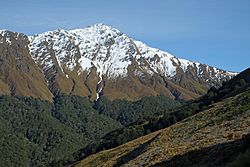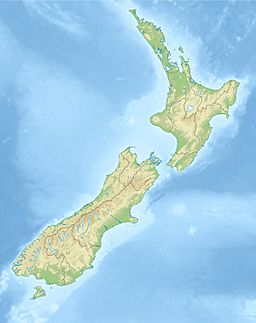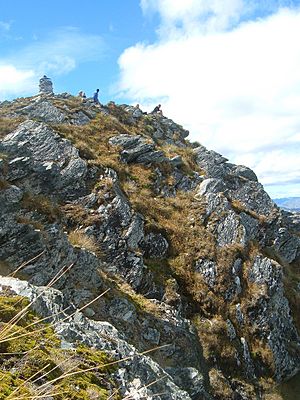Ben Lomond (Otago) facts for kids
Quick facts for kids Ben Lomond |
|
|---|---|
| Te-taumata-o-Hakitekura | |

Ben Lomond in spring, from near the start of Ben Lomond track on Cemetery Hill ( misnamed Bob's Peak)
|
|
| Highest point | |
| Elevation | 1,748 m (5,735 ft) |
| Geography | |
| Climbing | |
| First ascent | 1860 by W. G. Rees & N. von Tunzelmann |
Ben Lomond is a stunning mountain located very close to Queenstown, New Zealand. It was named after another mountain, Ben Lomond in Scotland, by an early shepherd named Duncan McAusland. The top of the mountain is about 4 kilometers northwest of Queenstown's town center. It reaches a height of 1,748 meters (5,735 feet).
From the top of Ben Lomond, you can see amazing 360-degree views! You'll spot much of the Wakatipu Basin, including the beautiful Lake Wakatipu. You can also see the impressive Remarkables Mountains, Cecil Peak, and Walter Peak.
Getting to Ben Lomond
There are a few main ways to start your adventure up Ben Lomond. You can begin at the One Mile Carpark or from Lomond Crescent.
The easiest way for many people is to use the Skyline Gondola. This cable car takes you partway up the mountain from Brecon Street. From there, you can start walking on the Tiki Trail.
If you're looking for a tougher challenge, you can try routes from the Moonlight Track. These start at either Moke Lake or Arthurs Point. Both lead to the Ben Lomond saddle, which is a dip between two peaks.
Exploring the Tracks
The main track on Ben Lomond takes you through different types of forests. You'll walk through tall Douglas Fir trees and then pass through Mountain Beech forests. As you go higher, the trees give way to open tussock grasslands.
The track follows a ridge up to a saddle between Ben Lomond and Bowen Peak. From the saddle, the path to the very top becomes quite steep. It's a challenging but rewarding climb!
There are also many other smaller tracks on Ben Lomond's slopes:
- The Fernhill Link Track is an easy path. It connects the suburbs of Fernhill and Sunshine Bay with Queenstown. You'll cross several bridges over streams.
- The Fernhill Loop Track is a longer walk or bike ride. It goes through Mountain Beech forest. However, this track is sometimes closed for maintenance.
- The Tiki Trail starts at the base of the Skyline building. It goes all the way up to the Luge area. These are just some of the many trails you can hike or run on Ben Lomond.
Fun Activities on the Mountain
Ben Lomond is a great place for outdoor activities! There are many walking and biking trails. Most of these are in an area near the base called the Ben Lomond Scenic Reserve.
If you love biking, you'll find a huge network of trails for Downhill mountain biking. You can bike uphill, get a ride up, or use the popular Skyline Gondola to take your bike up.
You can also walk on a service road that goes up Cemetery Hill. This hill is home to several businesses offering fun activities.
Cemetery Hill (Bob's Peak)
Cemetery Hill is a part of Ben Lomond that you can easily see from Queenstown. It's often mistakenly called Bob's Peak. This hill is mostly covered in Douglas Fir trees.
Several businesses use Cemetery Hill for exciting activities. The most famous is the Skyline Complex, which has a fun Luge track. You can also see people Paragliding here when the weather is good. A zipline company also operates near the complex, with lines running down towards Brecon Street.
It's interesting to know that while everyone calls this spot Bob's Peak, the actual Bob's Peak is officially located in a different area near Moke Lake on accurate maps.
Plants and Animals
At the lower parts of Ben Lomond, you'll find a large forest of Douglas fir trees. These trees are often mistaken for pine trees. There are also small areas of mountain beech trees. The faster-growing fir trees are slowly taking over these native beech forests. Higher up the mountain, you'll see larger patches of beech forest. There are also big areas of native tussock grass and herb fields.
You might spot the New Zealand pipit bird hopping around in the tussock looking for food. Tui and bellbirds are also commonly seen. If you're lucky, you might see a tomtit, Australasian harrier, wood pigeon, or even a kea (a clever mountain parrot!).
You might also see and smell feral goats all over the mountain. Since part of Ben Lomond is a farm called Ben Lomond Station, you'll also see many domestic cattle and sheep, especially on the trail from the saddle to Arthurs Point.
Protecting Ben Lomond's Nature
The Douglas Fir trees on Ben Lomond were first planted in the late 1800s. This was part of a project to make the area look nicer. More trees were planted in the early to mid-1900s.
However, since the 1960s, these fir trees have been spreading very quickly up the mountain. They grow faster here than in their home country of North America. This creates a forest with only one type of tree, which means less variety for native plants and animals. These fir trees have even taken over some older beech forests.
To help protect the native plants, different groups are working to control the fir trees. Here are some of the ways they do it:
- They pull out small young trees by hand.
- They cut the bases of larger trees that are one to three meters tall.
- They use chainsaws to chop down big trees over three meters tall.
- Sometimes, helicopters are used to spray areas high up that are hard to reach on foot.



